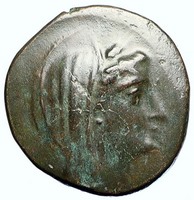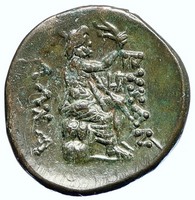Greek city of Byzantion in Thrace
Alliance coinage with Kalchedon
Bronze 25mm (10.26 grams) Struck Late 3rd-2nd centuries B.C.
Reference: Schönert-Geiss, Byzantion 1257–62; Türkoğlu A2a; HGC 3, 1428
Wreathed and veiled head of Demeter right.
BYZAN KAΛXA, Poseidon seated right, holding aphlaston and trident; dÅ to inner right. You are bidding on the exact item pictured, provided with a Certificate of Authenticity and Lifetime Guarantee of Authenticity.
 Poseidon was one of the twelve Olympian deities of the pantheon in Greek mythology. His main domain was the ocean, and he is called the "God of the Sea". Additionally, he is referred to as "Earth-Shaker" due to his role in causing earthquakes, and has been called the "tamer of horses". He is usually depicted as an older male with curly hair and a beard. Poseidon was one of the twelve Olympian deities of the pantheon in Greek mythology. His main domain was the ocean, and he is called the "God of the Sea". Additionally, he is referred to as "Earth-Shaker" due to his role in causing earthquakes, and has been called the "tamer of horses". He is usually depicted as an older male with curly hair and a beard.
The name of the sea-god Nethuns in Etruscan was adopted in Latin for Neptune in Roman mythology; both were sea gods analogous to Poseidon. Linear B tablets show that Poseidon was venerated at Pylos and Thebes in pre-Olympian Bronze Age Greece as a chief deity, but he was integrated into the Olympian gods as the brother of Zeus and Hades. According to some folklore, he was saved by his mother Rhea, who concealed him among a flock of lambs and pretended to have given birth to a colt, which was devoured by Cronus. There is a Homeric hymn to Poseidon, who was the protector of many Hellenic cities, although he lost the contest for Athens to Athena. According to the references from Plato in his dialogues Timaeus and Critias, the island of Atlantis was the chosen domain of Poseidon.
 Byzantium (Greek: Βυζάντιον Byzántion) was the ancient Greek city on the site that later became Constantinople (modern Istanbul). It was founded by Greek colonists from Megara in 657 BC. The city was rebuilt and reinaugurated as the new capital of the Roman Empire by Emperor Constantine I in 330 AD and subsequently renamed Constantinople. The city remained the capital until 1453, when it was conquered and became the capital of the Ottoman Empire. Since the establishment of modern Turkey in 1923, the Turkish name of the city, Istanbul, has replaced the name Constantinople in the West. Byzantium (Greek: Βυζάντιον Byzántion) was the ancient Greek city on the site that later became Constantinople (modern Istanbul). It was founded by Greek colonists from Megara in 657 BC. The city was rebuilt and reinaugurated as the new capital of the Roman Empire by Emperor Constantine I in 330 AD and subsequently renamed Constantinople. The city remained the capital until 1453, when it was conquered and became the capital of the Ottoman Empire. Since the establishment of modern Turkey in 1923, the Turkish name of the city, Istanbul, has replaced the name Constantinople in the West.
NameThe etymology of the Greek form Byzantion is unknown. In Greek legend it is said to be named after Byzas, the leader of the Megarean colonists and founder of the city. The name has been suggested as being of Thraco-Illyrian origin, perhaps indeed from a personal name Buzas. The form Byzantium is a Latinization of the Greek. HistoryThe origins of Byzantium are shrouded in legend. The traditional legend has it that Byzas from Megara (a city-state near Athens) founded Byzantium in 657 BC when he sailed northeast across the Aegean Sea. Byzas had consulted the Oracle at Delphi to ask where to found his new city. The Oracle told him to find it "opposite the blind". At the time, he did not know what this meant, but when he came upon the Bosporus he understood: on the opposite eastern shore was a Greek city, Chalcedon, whose founders were said to have overlooked the superior location only 3 kilometres (1.9 mi) away. Byzas founded his city there on the European coast and named it Byzantium after himself. It was mainly a trading city due to its location at the Black Sea's only entrance. Byzantium later conquered Chalcedon, across the Bosporus on the Asiatic side. After siding with Pescennius Niger against the victorious Septimius Severus, the city was besieged by Roman forces and suffered extensive damage in 196 AD. Byzantium was rebuilt by Septimius Severus, now emperor, and quickly regained its previous prosperity. It was bound to Perinthos during the period of Septimius Severus. The location of Byzantium attracted Roman Emperor Constantine I who, in 330 AD, refounded it as an imperial residence inspired by Rome itself. (See Nova Roma.) After his death the city was called Constantinople (Greek Κωνσταντινούπολις or Konstantinoupolis) ("city of Constantine"). This combination of imperialism and location would affect Constantinople's role as the nexus between the continents of Europe and Asia. It was a commercial, cultural, and diplomatic centre. With its strategic position, Constantinople controlled the route between Asia and Europe, as well as the passage from the Mediterranean Sea to the Black Sea. On May 29, 1453, the city fell to the Ottoman Turks, and again became the capital of a powerful state, the Ottoman Empire. The Turks called the city "Istanbul" (although it was not officially renamed until 1930); the name derives from "eis-tin-polin" (Greek: "to-the-city"). To this day it remains the largest and most populous city in Turkey (the successor to the Ottoman Empire), although Ankara is now the national capital. EmblemMain article: Star and crescentThough associated with the Sassanid Persians and with Mithradates VI Eupator (who for a time incorporated the city into his empire), by the late Hellenistic or early Roman period, the star and crescent motif had been associated to some degree with Byzantium. For example, some Byzantine coins of the 1st century BC and later show the head of Artemis with bow and quiver, and feature a crescent with what appears to be a six-rayed star on the reverse. According to accounts which vary in some of the details, in 340 BC the Byzantines and their allies the Athenians were under siege by the troops of Philip of Macedon. On a particularly dark and wet night Philip attempted a surprise attack but was thwarted by the appearance of a bright light in the sky. This light is occasionally described by subsequent interpreters as a meteor, sometimes as the moon, and some accounts also mention the barking of dogs. However, the original accounts mention only a light in the sky, without specifying the moon. To commemorate the event the Byzantines erected a statue of Hecate lampadephoros (light-bearer or bringer). This story survived in the works of Hesychius of Miletus, who in all probability lived in the time of Justinian I. His works survive only in fragments preserved in Photius and the tenth century lexicographer Suidas. The tale is also related by Stephanus of Byzantium, and Eustathius. Devotion to Hecate was especially favored by the Byzantines for her aid in having protected them from the incursions of Philip of Macedon. Her symbols were the crescent and star, and the walls of her city were her provenance. It is unclear precisely how the symbol Hecate/Artemis, one of many goddesses would have been transferred to the city itself, but it seems likely to have been an effect of being credited with the intervention against Philip and the subsequent honors. This was a common process in ancient Greece, as in Athens where the city was named after Athena in honor of such an intervention in time of war. Later, under the Romans, cities in the empire often continued to issue their own coinage. "Of the many themes that were used on local coinage, celestial and astral symbols often appeared, mostly stars or crescent moons." The wide variety of these issues, and the varying explanations for the significance of the star and crescent on Roman coinage precludes their discussion here. It is, however, apparent that by the time of the Romans, coins featuring a star or crescent in some combination were not at all rare. Notable people- Homerus, tragedian, lived in the early 3rd century BC
- Philo, engineer, lived ca. 280 BC-ca. 220 BC
- Epigenes of Byzantium, astrologer, lived in the 3rd-2nd century BC
- Aristophanes of Byzantium, a scholar who flourished in Alexandria, 3rd-2nd century BC
See also- Constantinople details the history of the city before the Turkish conquest of 1453.
- Istanbul details the history of the city from 1453 on, and describes the modern city.
- Sarayburnu is the geographic location of ancient Byzantium.
- Timeline of Istanbul history
|


 Poseidon was one of the twelve Olympian deities of the pantheon in Greek mythology. His main domain was the ocean, and he is called the "God of the Sea". Additionally, he is referred to as "Earth-Shaker" due to his role in causing earthquakes, and has been called the "tamer of horses". He is usually depicted as an older male with curly hair and a beard.
Poseidon was one of the twelve Olympian deities of the pantheon in Greek mythology. His main domain was the ocean, and he is called the "God of the Sea". Additionally, he is referred to as "Earth-Shaker" due to his role in causing earthquakes, and has been called the "tamer of horses". He is usually depicted as an older male with curly hair and a beard. Byzantium (Greek: Βυζάντιον Byzántion) was the ancient Greek city on the site that later became Constantinople (modern Istanbul). It was founded by Greek colonists from Megara in 657 BC. The city was rebuilt and reinaugurated as the new capital of the Roman Empire by Emperor Constantine I in 330 AD and subsequently renamed Constantinople. The city remained the capital until 1453, when it was conquered and became the capital of the Ottoman Empire. Since the establishment of modern Turkey in 1923, the Turkish name of the city, Istanbul, has replaced the name Constantinople in the West.
Byzantium (Greek: Βυζάντιον Byzántion) was the ancient Greek city on the site that later became Constantinople (modern Istanbul). It was founded by Greek colonists from Megara in 657 BC. The city was rebuilt and reinaugurated as the new capital of the Roman Empire by Emperor Constantine I in 330 AD and subsequently renamed Constantinople. The city remained the capital until 1453, when it was conquered and became the capital of the Ottoman Empire. Since the establishment of modern Turkey in 1923, the Turkish name of the city, Istanbul, has replaced the name Constantinople in the West.
